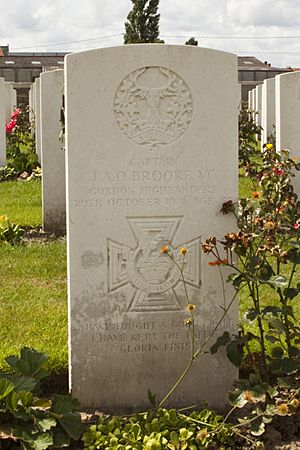James Anson Otho Brooke facts for kids
Quick facts for kids
James Anson Otho Brooke
|
|
|---|---|

Captain Brooke's grave in Zantvoorde British Cemetery, Zonnebeke, Belgium
|
|
| Born | 3 February 1884 Aberdeen, Scotland |
| Died | 29 October 1914 (aged 30) Gheluvelt, Belgium |
| Buried |
Zantvoorde British Cemetery
|
| Allegiance | |
| Service/ |
|
| Years of service | 1905-1914 † |
| Rank | Captain |
| Unit | The Gordon Highlanders |
| Battles/wars | First World War |
| Awards | Victoria Cross |
James Anson Otho Brooke (born February 3, 1884 – died October 29, 1914) was a brave Scottish soldier. He received the Victoria Cross, which is the highest award for courage given to soldiers in the British and Commonwealth forces. This medal is given for incredible bravery when facing the enemy.
Contents
Early Life and School
James Brooke grew up in a well-known family in Aberdeenshire, Scotland. His father, Harry Vesey Brooke, was also a captain in the Gordon Highlanders, a famous Scottish army regiment.
James went to school at Wellington College, Berkshire. After that, he studied at the Royal Military College, Sandhurst. This is where many British army officers train. In 1905, he officially joined the Gordon Highlanders as a second lieutenant.
Military Service
James Brooke became a lieutenant in 1907. He served with the 2nd Battalion of the Gordon Highlanders. They were stationed in India for several years, then in Egypt.
When the First World War began in 1914, his unit was sent to the front lines. Lieutenant Brooke was an important officer, helping the adjutant (a senior officer).
Heroic Actions in Battle
Lieutenant Brooke showed amazing bravery during the First Battle of Ypres in Belgium. This is why he was awarded the Victoria Cross.
On October 29, 1914, near Gheluvelt, Belgium, his unit was in a very tough fight. The German army was attacking strongly. Lieutenant Brooke bravely led two attacks against the German trenches. He did this even though there was heavy rifle and machine-gun fire.
He managed to get back a trench that the British had lost. This was a very important moment in the battle. His calm and quick thinking stopped the enemy from breaking through the British lines. If he hadn't acted so fast, the British might not have been able to organize a counter-attack.
After taking back the trench, Lieutenant Brooke went back to get more soldiers to help. Sadly, he was killed while doing this.
Because of his incredible courage, Lieutenant Brooke was promoted to Captain after his death. This promotion was made official from September 1914.
Remembering Captain Brooke
Captain Brooke was buried at the Zantvoorde British Cemetery in Zonnebeke, Belgium. This cemetery is cared for by the CWGC. His name is also on his family's grave in Springbank Cemetery, Aberdeen.
Many other places remember Captain Brooke:
- His name is on the Aberdeen War Memorial.
- He is also remembered on the Colebrook War Memorial, St Ronan's Church Memorial, and Enniskillen War Memorial.
- A large mortar (a type of cannon) that he captured is on display at Enniskillen Castle.
In October 2014, a special stone was placed at Kingswells Hall near Aberdeen. This stone honors Captain Brooke and marks 100 years since he was awarded the Victoria Cross. He had helped build this hall, and the church war memorial across from it also has his name.
The Victoria Cross Medal
Captain Brooke's Victoria Cross medal is on display for everyone to see. You can find it at the Gordon Highlanders Museum in Aberdeen, Scotland.
See also
- List of 1914 First World War Victoria Cross recipients

